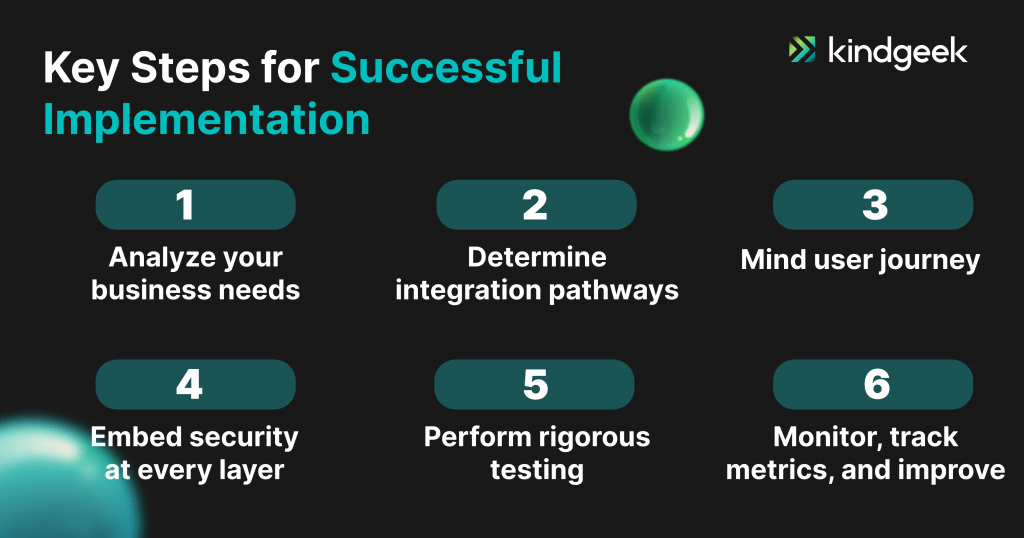Pursuing digital transformation, responding to market pressures, working on customer retention – modern businesses have a lot on their plate. Being plagued by multiple challenges, organizations often struggle to effectively meet ever-growing demands.
And the issue here doesn’t primarily lie in limited resources. Oftentimes, the struggle stems from internal inefficiencies.
While seeming completely harmless, low-value tasks scatter focus, trap teams in unproductive cycles, and create busy work without progress.
The solution? Enterprise chatbots. Today, these tools stand as ultimate game-changers, helping businesses reclaim agility, boost team collaboration, enhance customer-facing processes, and simply do more with less – all without sacrificing quality.
In this article, let’s talk about enterprise AI chatbot solutions, their functionalities, and tech stack, discuss benefits, and implementation strategies.
The Rise of AI Chatbots in Enterprise
Amid current AI advancements, businesses in multiple industries actively turn to its superpowers. The enterprise AI market is projected to reach $97.2 billion in 2025 and soar to $229.3 billion by 2030, growing at a robust CAGR of 18.9%.
This rapid expansion is fueled by the widespread adoption of generative AI, the emergence of agentic systems that automate complex, multi-step tasks, and a broader shift toward intelligent automation that’s redefining how enterprises operate and compete.
Understanding Enterprise Chatbots
Enterprise chatbots are sleek chat interfaces that run on robust AI technology to optimize a large volume of both front- and back-office business operations 24/7.
With them on board, organizations can automate activities at scale, unleash new levels of productivity, maximize customer reach, and remain responsive without trade-offs in quality.
Several distinctive features differentiate them from standard chatbots, including:
Smart handling of requests
Enterprise chatbots can handle both basic and complex, multistep requests at once without downtime, allowing for better and much faster issue resolution than traditional bots. They are well-versed in corporate data and can support users with the most accurate and up-to-date information.
Integrations with enterprise software
These tools can integrate smoothly with any essential suite of third-party applications used by businesses. That makes them robust powerhouses supporting cohesive information flow across the entire organization, driving efficiencies and service quality.
Ability to cover multiple use cases
Enterprises can tailor the chatbot to serve their unique set of business use cases. The AI chatbots are capable of accommodating the needs of any department, eliminating the need for multiple disparate tools or systems.
Continuous improvement through ML
The tech allows chatbots to be adaptive and proactively learn from experience and customer feedback to improve the quality of outputs in the future without any additional programming.
Multilingual chatbots
As enterprises have geographically dispersed teams and serve a global customer base, such chatbots can cater to users’ preferred language, eliminating any possible barriers.
Seamless transition to a human agent
While enterprise chatbots can handle complex cases, they can manage a smooth context-driven hand off to a live agent whenever human support is requested.
Multimodal Capabilities
No matter the communication method, an enterprise chatbot solution should be savvy to process and switch between multiple data formats – be it audio or images – driving richer communication and ensuring a consistent experience.
Exploring How Enterprise Chatbots Operate
To meet the demands of multitasking and intelligent automation, a chatbot for enterprises is built utilizing various technologies that enable them to efficiently grasp the complexities of human language, process and analyze it, enhance with time, and learn from mistakes.
Here we outline some of the core technologies used to power modern chatbots:
Machine Learning and advanced AI
While rule-based chatbots can benefit companies in certain use cases, more and more enterprises go for chatbots powered by advanced AI models. Indeed, there are plenty in the market today, as today’s artificial intelligence landscape flourishes immensely. They offer multiple performative AI models that are pleasant and easy to interact with.
They leverage natural language processing (NLP) and machine learning (ML) to deliver context-aware, adaptive responses across diverse scenarios.
Speaking about ML, it’s yet another essential component needed for a chatbot’s seamless performance. It allows bots to learn from past interactions, enabling them to adapt and get smarter continuously. By analyzing previous conversations, chatbots for enterprise can fine-tune their algorithms to deliver more relevant responses over time.
Natural Language Processing (NLP)
Being a subset of AI, natural language processing (NLP) is a fundamental component of modern enterprise chatbots, allowing them to effectively analyze, comprehend, and communicate with human language. Given the emergence of NLP at the high level that OpenAI currently demonstrates, the standards have definitely been raised.
Modern NLP architectures leverage deep learning, attention mechanisms, and transformer-based models to achieve context-aware understanding and text generation.
Beyond basic automation, NLP-driven chatbots act as intelligent digital employees – capable of taking context into account, understanding sentiment, predicting needs, and providing tailored responses that reflect brand voice.
Key Steps for Successful Implementation
Ultimately, a chatbot’s effectiveness stems from the interplay between technological capability and the quality of its implementation strategy. Here we’ve outlined key steps allowing enterprises to move from concept to execution.

1. Analyze your business needs
Before starting the journey, you need to carefully assess your unique needs and define how a chatbot aligns with your overarching business objectives.
What specific challenges are you aiming to solve, and how can AI enhance existing workflows or customer interactions? What value will it bring to your organization, and how will it integrate into your broader digital transformation strategy?
Also, think about how success will be measured across teams, processes, and user experience.
From those points on, proceed to form a portfolio of relevant use cases you want the chatbot to handle. Note that there’s no need to rush and start big at once – prioritize the use cases based on the benefits they can generate early on, form a roadmap, and progress toward it.
2. Determine integration pathways
To boost productivity and combat cross-departmental silos, a chatbot should fit into your existing infrastructure to pull necessary data from your corporate systems – CRM, ERP, backend systems, and databases. Such a move ensures up-to-the-minute information, accurate responses to requests, consistent data flow, and ultimately smooth operations.
Additionally, determine the most effective channels for deploying your enterprise chatbot to maximize reach, usability, and engagement.
3. Mind user journey
Mind the user journey by mapping out how customers interact with your organization before introducing the chatbot. Identify key stages where users may hesitate or encounter challenges to offer helpful support, reducing friction or speeding up outcomes.
By analyzing customer touchpoints and identifying moments where automation adds efficiency or clarity, organizations can design chatbot interactions that feel seamless and supportive.
4. Embed security at every layer
Since a chatbot enterprise solution deals with sensitive corporate and customer data, security should never be an afterthought.
From data storage and user authentication to third-party integrations and data-handling policies, design every layer with protection in mind to prevent vulnerabilities, ensure compliance with regulations like GDPR, and maintain user confidence.
5. Perform rigorous testing
Before you commit to a full-scale deployment, test the chatbot with a focus group to uncover any hidden gaps in the chatbot’s performance. This controlled testing phase allows you to observe real interactions – see how the bot addresses complex requests, how it handles edge cases – and gather valuable feedback for refinement.
By addressing issues early on, you can ensure a smoother experience when it is rolled out company-wide.
6. Monitor, track metrics, and improve
While deploying an enterprise chatbot is a significant milestone, yet it’s not a completion of the journey. It’s a starting point for a broader enterprise chatbot strategy. Conduct periodic reviews of the chatbot’s performance and user feedback to enhance chatbot efficiency and accuracy.
It’s equally important to track performance metrics to identify improvement opportunities and ensure the tool delivers its intended value.
By fostering a culture of continuous monitoring and improvement, you can ensure your chatbot evolves alongside user needs and business goals.
Top 3 Benefits of Enterprise Chatbots
1. Increase organizational efficiency
Enterprise chatbots greatly help optimize a vast number of activities and repetitive processes – both internal and customer-facing – allowing your organization to boost operations and achieve more with less. A whopping 86% of professionals claim that adopting AI has enabled them to scale and expand their operations.
Here are some of the ways savvy bots contribute to creating smarter, faster, and more efficient operations:
- automate manual work processes (e.g., processing orders, handling payments), troubleshoot issues, and assist with several administrative tasks like employee onboarding.
- facilitate smooth communication across teams and departments, and support employees with the latest data, helping them stay updated and efficient in their routines.
- provide a foundation for establishing a data-driven culture that empowers employees to make informed, evidence-based decisions.
- support lead generation and marketing activities by gauging customer intent, qualifying leads, collecting key user data, and facilitating upselling and cross-selling driven by personalization.
- offering human-like support and convenient self-service options for quick issue resolutions, better satisfaction rates, and increased customer lifetime value.
2. Reduce operational costs
Considering that all points mentioned above are performed by the chatbot 24/7, at scale, and without sacrificing quality, a strategic investment into the enterprise AI chatbot solution stands as a solid value-for-money.
While increasing human productivity, AI deployment allows you to optimize human efforts, slash excessive operational costs, and redirect those funds to more strategic areas of your business.
As an example, chatbots can accelerate service delivery, improving customer support response times by more than threefold. And Gartner predicts AI to cut support agent labor costs by a staggering $80 Billion in 2026.
3. Boost engagement and sales
Market data shows that over 41% of organisations utilize chatbots for sales purposes. And there are several valid reasons for that.
Enterprise chatbot solutions are always there for your customers, guiding them through processes and offering proactive support and handy notifications. They carefully interact with users across multiple touchpoints, gauge patterns and behavior to suggest personalized offerings or complementary products based on this information, helping capitalize on upsell and cross-sell.
With value being obvious, business leaders report increased sales performance by 67%.
Indeed, the collected data from interactions serves as a valuable resource, powering you with insight to further improve your product and services.
Last but certainly not least, your employees also remain cared for. With chatbots on board, they don’t get stuck in hectic cycles of low-value tasks, but can focus their efforts on activities that require human input and creative thinking. By streamlining processes, automation delivers superior employee experiences, boosts their engagement, and contributes to measurable business impact – with studies citing revenue growth of up to 50%.
Final Thoughts
As the market evolves quickly, so do business standards and customer expectations. For enterprises, implementing an enterprise AI solution is no longer a simple add-on – it’s a strategic initiative that shapes digital transformation.
But as the tech advances tremendously, a move towards composability (flexibility to integrate and interchange models, data layers, and infrastructure components) will help organizations stay agile, future-proof their AI investments, and accelerate innovation. Indeed, Gartner reinforces this view, projecting that by 2026, organizations embracing composable architectures will outperform competitors by 80% in the speed of feature delivery.
Ultimately, success in the era of enterprise AI will depend not only on adoption but on adaptability – the ability to evolve, experiment, integrate, and innovate continuously. Those organizations that embrace such a mindset will be best positioned to capitalize on emerging opportunities and maintain a lasting competitive edge.




